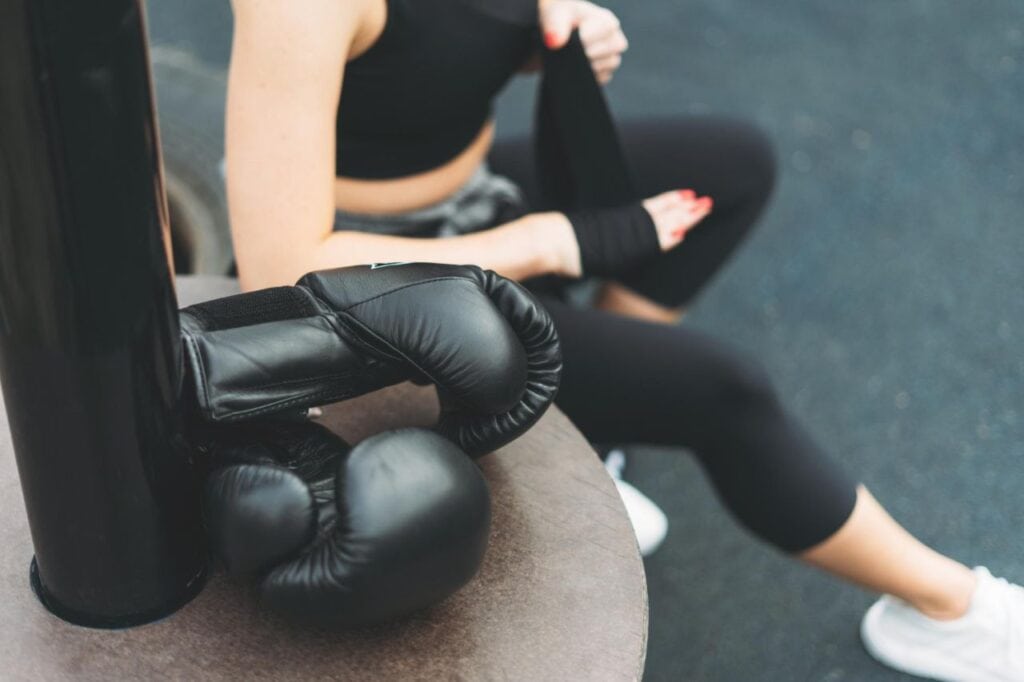Most boxers run and jump rope as part of their regular conditioning program. Both exercises develop endurance and cardiovascular conditioning and strengthen muscles of the upper and lower body.
Jumping rope works more skills specific to boxing, but both exercises are an important part of a complete boxing program.
Running and jumping rope is common exercise types for boxing, and many people wonder and want to find out which one is better for their boxing training routine.
Even though many people think that jumping rope is better for boxing, there are some circumstances, and running can be better for this. Body Conditioning works your whole body for the improvement of your overall fitness.
It offers you several benefits, including improving the tone of your body, physical fitness, cardiovascular functioning, and weight loss.
What's more? It also offers a lasting sense of wellbeing and keeps you calm.
Furthermore, it raises your consciousness. Considering this, making body conditioning exercises a part of your daily fitness regime is essential for every sportsperson as a whole and boxers in particular.
Notably, you can take advantage of certain body conditioning exercises for outperforming in the ring.
Running and jumping rope incorporates two different movements. The differences in movement also translate into different uses of certain muscle groups. Running involves forward movement and repeatedly puts the entire body through the full gait cycle.
The gait cycle flexes and releases the muscles of the foot, ankle, knee, and hip through each step's stance and swing phases.
Jumping rope is a predominantly stationary activity that conditions the muscles of the foot, ankle, knee and hip through repeated, weight-bearing impact. Jumping rope also develops grip strength and uses the back, shoulders, biceps, triceps and forearms to hold and turn the rope.
Boxing Conditioning: Jumping Rope Vs. Running
Becoming a boxer is not an easy feat. It requires strength, stamina, and agility to quickly move the body to block, slip and react appropriately. In addition, boxers must develop their cardiovascular endurance and strengthen the muscles in their upper and lower bodies.
Two of the best exercises to condition the body for boxing is skipping (jumping rope) and running, as both offer major benefits to outfight and outlast an opponent in the ring.
Running and jumping rope has lots of benefits for boxing skills, and one of these is footwork. Footwork is a simple must for Jumping rope vs Running for people who train boxing. When you improve your footwork, it will positively affect almost ALL of your skills.
You will punch better, have more balance etc. Both running and jumping rope will give you a lighter, quicker foot. Also, skipping rope will provide better results because your ankle muscles will work more during skipping.
And you will get used to bouncing in the process. In this way, you will move effortlessly during sparring and save energy. As you may know, extra energy can be the difference between winning and losing in a match. So here, jumping rope is a giant step ahead of running.
Which One Is The Best Body Conditioning Exercise For Boxers?
It's not easy to become a boxer, not at all. It demands strength, agility, and stamina for moving the body quick enough to slip, block, and react appropriately. Not to mention, boxing is a tough sport and requires proper conditioning in training for hitting the nail on the head.
Strengthening the muscles in the lower and upper bodies is essential for boxers, but developing their cardiovascular endurance is also important. You can do this by following the body conditioning exercises below.
How about Muscles?
Certainly, your muscles will be denser with both of these training types. With that, jumping rope will challenge your muscles more, especially your shoulders, arms and wrists. It will put some serious tension on your muscles, and it is great for making these toned.
This is one of the reasons that boxers have more toned muscles.
And when you are an expert with speed ropes, there are also weighted ropes. And these will put even more tension on your working muscles.
Running is also effective for conditioning your body; however, your upper body muscles don't face any resistance. So even though you will lose fat, it is far less effective for having denser muscles.

Running
According to an American study on common exercise, running is the most popular form of exercise. Like skipping, running helps build both physical and mental endurance and stamina, which comes in handy in the later stages of each round.
The biggest benefit to running is that it doesn't require any equipment and can be done virtually anywhere.
However, although great for stamina as it increases athlete's aerobic capacities, running doesn't offer boxers the same technical footwork conditioning that skipping does to improve quickness on the feet.
Long-distance runs are responsible for improving endurance, but short duration, high intensity sprinting intervals will recruit the fast-twitch muscle fibres to condition the muscles necessary to win boxing rounds. In addition, Sprinting strengthens the anaerobic energy pathway used during boxing, as muscles are stressed at high intensities for short rounds.
Cardio Conditioning
Endurance is essential to stay competitive throughout a boxing match. Both are running and jumping rope effectively develop cardiovascular, or cardio, conditioning. For example, a 160-pound individual running at 5 mph burns 606 calories in an hour.
The same individual jumping rope for 60 minutes burns 861 calories.
Though these statistics indicate jumping rope as the more effective form of exercise, keep in mind that intensity changes the efficacy of either exercise. For example, a 160-pound individual running at 8 mph for an hour burns the same amount of calories as jumping rope.
Running faster or for a longer time or jumping rope at a faster pace will alter how much cardio you gain from one exercise or the other.
Since having enough stamina and endurance is crucial for every boxer out there, getting benefits from running can help you achieve this goal. So let's look at some other benefits running can give you:
- Speeds Up Losing Weight: Running is a great approach to losing weight in a short amount of time. An individual weighing 72 kg (160 lbs) running at 8 kph (5 mph) utilises 606 calories in one hour per the mayo clinic.
- Makes You More Disciplined: Aside from that, an essential thing to have in boxing is the discipline that comes with running. You get up early in the morning and run a certain distance every day. This is what makes you as fit as a fiddle, and that's what every sportsperson should be.
- Improves Heart Health: Running increases the heart rate and, in this way, improves heart and circulatory system conditions. If you keep on running for 2-3 hours daily (for five days a week), you will adapt to it, which will increase your aerobic capacity.
- Diversity: You can add variation in your running workout to make this physical activity even more exciting and gainful. Wondering how? Well, you can run by lifting different heavyweight tools, which will also build your muscles.
As You Get Better Running Becomes More Important
Suppose you will be sparring, having amateur fights or going on to box professionally. In that case, you will want that steady pace aerobic cardio of jogging, and you will want to stretch out your fast-twitch muscle fibres with sprints before you are jumping in the ring.
This will help you to last 3,6,9, or 12 rounds every time with only a short break in between.
How Much Should I Run For Boxing
This will vary greatly from person to person, but generally, 1-3 runs of 5km to 10km should suit most boxers and even amateur fighters. Pro's fighting in longer bouts should run 3-5 times a week and incorporate sprints and hill sprints into their workouts as well.
Jumping/Skipping Rope
Walk into a boxing gym, and you'll immediately hear the familiar rhythmic sounds of skipping ropes repeatedly striking the ground. There's a reason skipping is internationally recognised as a boxer's key conditioning exercise.
Skipping engages the wrists by turning the handles of the skipping rope while focusing on hopping both feet over the rope as it reaches the floor again and again.
Speed and other variations can be added to skipping to challenge the body differently. For example, try turning the handles faster, adding a second hop between skips, or getting the rope under the feet twice in one hop.
These variations are key to increasing boxers' ability to time their movements in their footwork and punches while maintaining balance. Without timing punches in coordination with the correct footwork placement, empty punches lacking force and power will result.
Ultimately, skipping helps boxers develop the technical footwork vital for ring movement. It's one of few conditioning exercises that simultaneously improve aerobic and anaerobic energy pathways as it elevates the heart rate while recruiting several different muscle groups throughout the lower and upper body. Skipping builds speed, quickness in the feet, endurance, and agility.
- Jumping Rope. The basic form of rope jumping involves jumping slightly with each rope swing, keeping your feet close to each other. Jumping once per revolution is easiest, but doing two small hops instead can increase the difficulty of the exercise and lead to greater fitness benefits. Other ways to make rope jumping more intense include swinging the rope faster and jumping higher off the ground. At first, though, focus on establishing a steady rhythm and getting used to the motions.
- Skipping Rope. Once you master the basics of rope jumping, move on to skipping rope. To skip rope, swing the rope forward as normal. But instead of jumping with both feet close together, do a shuffle-like movement as you hop in which one leg stays beneath you while your other foot moves forward, toes up. The rope first passes under your front foot and then in the centre position. When you hop for the next swing of the rope, reverse the position of your legs.
Other Benefits
In addition to burning calories, aerobic exercises such as running and jump rope will increase your stamina, reduce health risks and manage chronic conditions such as high blood pressure and cholesterol.
Running and jumping rope can be anaerobic exercises if you increase your pace. For example, pushing your heart rate to 80 or 90 per cent of its maximum through speed rope or sprinting will put you in the anaerobic zone, causing you to burn more calories without losing muscle mass.
Besides, skipping/jumping rope goes a long way for the boxers. So, let's see what other benefits it offers boxers:
- Improves Balance: While skipping rope, you repeatedly practice wrist-turning, hopping over the rope. As your confidence level goes up, you will perform this exercise faster by quickly rotating the rope. Doing so assists your ability to time movements and enables you to throw punches with proper balance.
- Enhances Coordination: It enhances coordination, which every boxer requires for moving around the ring, defending, punch as well as a counterattack. It's a complex process to skip a rope involving the execution of various tasks simultaneously. Such as hand-eye coordination by using the hands to spin the rope.
- Improves Footwork: Another amazing benefit of skipping rope for boxers is developing footwork for ring movement. Having a solid base below the torso is the key to throwing a powerful punch. Moving your feet properly enables the boxer to throw punches crisply and cleanly, causing damage and assisting in avoiding the opponent's punch.
- Best Type Of Warm-Up: Among the best warm-ups for any boxing workout is skipping rope. This type of warm-up sufficiently increases your core temperature without causing you excess fatigue.
- Strips Down Pounds: Needless to say, jumping or skipping rope efficiently burns a lot of calories; thus, giving you a killer figure in a short period. An individual skipping rope for one hour burns 861 calories per the mayo clinic. Healthy body weight is not only vital for living a healthier life but for acing all your bouts as well. Besides this, skipping rope is an excellent way of improving cardio and leg muscle endurance, in particular, the calves.
- Portability and Affordability: To your delight, buying a rope to start skipping is extremely affordable. The cherry on the top, you can carry the rope anywhere since it's very light weighing. All in all, both these aspects make skipping rope anywhere and anytime possible for you and that too by keeping with your means.
The Superior Exercise
Jump rope has a few distinct advantages over running in that it involves upper-body muscles more, increasing strength in your arms, shoulders and back.
Boxers and mixed martial arts fighters use a jump rope to improve coordination, footwork and agility -- benefits you're unlikely to get from running. But it's hard to beat the simplicity and versatility of running since you can do it virtually anywhere and at any level of intensity.
Negatives
Running and jump rope doesn't seem like high-impact exercises, but damage due to repeated impacts can add up over time. Both forms of exercise stress your feet, ankles, knees and hips.
While jump rope has some advantages over running, it also has a much steeper learning curve, and it's unlikely that a beginner can keep up a steady pace long enough to get the same health benefits as running.
Varying your jumping patterns takes skill and practice.
Considerations
The number of calories you'll burn jumping rope depends on your level of exertion, but not so much on the particular style you choose.
Skipping rope, for example, might not burn more calories than normal rope jumping, although the more challenging movement can improve lower-body coordination.
But if you choose a style of rope jumping that is more physically intensive than usual -- for example, if you focus on lifting your knees as high as possible on every jump -- you might be able to burn some extra calories.
Conclusive Thoughts
As you can see, jumping rope has so many incredible benefits, including having better footwork, balance and coordination. These are directly correlated with boxing skills improvement. And let's not forget that it also increases focus.
These are all good, right? However, if you start boxing training and don't have any skipping rope skills, learning how to skip rope can take your time, and if you don't have any cardio exercise in your workout routine, then it is ideal for you to start running and get your cardio.

In this way, you will keep your energy at a certain level during other boxing training types.
And when it is time to concentrate on your boxing skills such as footwork, timing, etc., it is time to get a jump rope.
FAQs
Does Skipping/Jumping Rope Improve Footwork For Boxing?
Yes, skipping is great for improving footwork as you have to constantly be moving and make sure your feet are in the correct position at all times. It also builds coordination between the hands and feet to allow you to glide around the ring effortlessly.
Skipping is also progressive, so as you get better, you can add new tricks to your routine, and your footwork should continue to get better as you push ahead.
How Long Should You Do Skipping/Jumping Rope In Boxing?
If you are warming up for a boxing workout with skipping, we recommend 3 * 2 Minute rounds or 3 * 3-minute rounds. This will get you used to working solidly for 3 minutes and then resting for a minute to mirror a fight.
You can also increase the pace gradually to get your heart rate up and get you ready for your full workout.
Is Running Good For Boxing?
Boxers know that running increases endurance in the ring and helps you in the last 30 seconds of those three-minute rounds. So boxing and running are both aerobic exercises. That's why roadwork (aka a boxer's term for running) goes hand-in-hand with boxing.
Is Running More Effective Or Skipping?
The average peak force on the tibiofemoral joint (the knee hinge where the femur, tibia, and patella meet) is 30 per cent greater in people who run than people who skip. What's more, skipping allows for a greater calorie burn. Skippers burn 30 per cent more calories than runners, the study found.
Is Skipping Harder Than Running?
As it turns out, just jumping up and down is a more efficient workout than pounding the pavement—achieving the same results in a fraction of the time. According to research, jumping rope at a moderate pace roughly equivocates to running an eight-minute mile.
- Find a gym. Boxing gyms aren't typically found in the yellow pages, but there are resources on the internet that can lead you in the right direction. ...
- Be sure the gym is within striking distance. ...
- Be open-minded. ...
- Choose your coach carefully. ...
- Do judge the gym by its cover.
So, can boxing be self-taught? Boxing can be self-taught but it's not the quickest and most effective way to become better at the sport because you aren't able to tap into the knowledge of a boxing coach who would be able to help you one to one.
Best Age to Start
Specialists in sports medicine believe that boxing classes are better to start from 9-10 years. Starting too early could result in putting the student off, as boxing is hard work and not always as fun as team sports, such as football or rugby.

